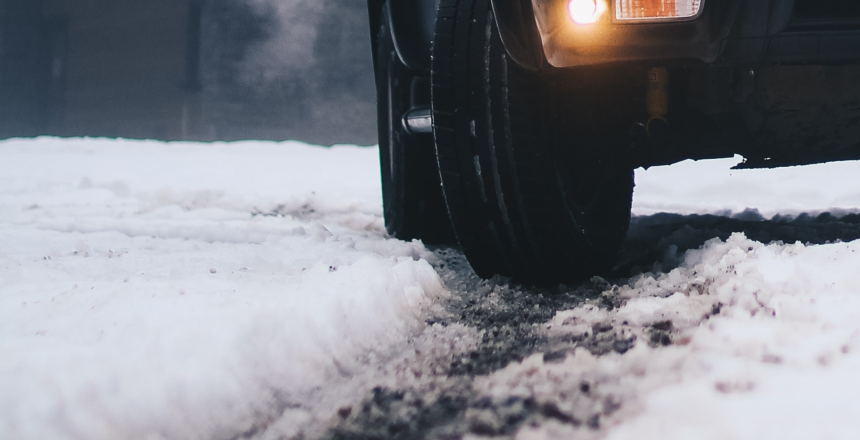Winter is an incredibly hard season for concrete. After a long winter with ice and snow, and the snow removal that comes with them, your poor concrete driveway may see some significant damage come spring. That’s because the freeze-thaw cycle of extra moisture in concrete expands and contracts the structure of the concrete itself. But with the right prep work, you can winterize concrete driveways so that they can survive harsh winters and come out looking beautiful.
Types of Concrete Damage to Watch For
To winterize concrete driveways the right way, you’ll want to prevent or repair three main types of damage: pitting and spalling, cracks, and heaving. These three issues come up when moisture isn’t managed properly, and when your snow and ice removal efforts do unnecessary damage.
Cracks
Both small surface cracks and deep cracks in your driveway can cause serious problems over the winter if they aren’t addressed properly. These cracks are caused by shifting or heaving, improper curing, or loads that go beyond the concrete’s rated strength. The problem with cracks is that they allow moisture and brine to seep into and under the concrete, where it will cause more damage to the pad itself.
Heaving
When that water gets under the concrete pad and starts thawing and freezing, it will create voids under the driveway. These voids allow the concrete driveway to shift out of place, causing even more cracking and breaking. That freeze-thaw cycle also pushes sections of your driveway up during the winter, leaving them to sink again when the weather changes.
Pitting and Spalling
The third type of damage you’ll need to address is pitting and spalling. These two issues are both due to weathering and use, but they pop up even more often with the use of chemicals during the winter months. What you’ll see is the top layer of the cement chipping and breaking, leaving uneven surfaces instead of smooth, level concrete.
How to Winterize Concrete Driveways
The main goal to winterize concrete driveways is to mitigate and minimize water and moisture damage by repairing cracks, resurfacing uneven concrete, and sealing slabs to keep moisture from getting into the concrete. Most winterizing processes should be done about once per year, although some can be beneficial on either side of winter. Now that you know what to look for, it’s time to see how to winterize concrete driveways so that they can last through season after season without losing their lifespan.
Clean Your Concrete
Your first step should be getting your concrete driveway clean. Sweep off any debris or dirt to start. But for more ground-in dirt and soil, you’ll want to power wash the driveway. The power washing will get out most deep stains and dirt that have built up over the warmer seasons. If there are oil, grease, or any other major stains left behind after power washing, get a concrete stain remover to eliminate these tougher stains.
Repair Cracks in Your Concrete Driveway
With the concrete driveway clean, it’s time to repair the cracks. A polyurethane crack repair kit offers a moisture-sealed solution that stretches and contracts with temperature fluctuations. The depth and size of the cracks will determine your final solution, but you should always look for flexible and watertight repair options. We also recommend sealing expansion joints to minimize water seepage without inhibiting their ability to shift with expansion and contraction.
Resurface Your Driveway to Repair Spalling
The spalling and pitting we mentioned above requires a bit more involved repair. But there are DIY repair kits available to solve these problems. Use a resurfacing mixture or kit to add a layer of concrete on top of your original driveway. Resurfacing mixes will chemically bond with the older concrete, creating a solid top layer that should match your existing concrete driveway.
Seal the Concrete
And now that all your repairs are made, it’s time to seal the concrete. This is the final step to winterize concrete driveways, and it’s the step that will keep moisture from soaking into the pours within the concrete throughout the year, keeping your concrete from expanding too much during the frigid winter months. Concrete sealers should be applied at least annually, although applying them before the snow falls and again after it melts away will provide the best protection against moisture-related damage.
De-Ice with Care
Once you winterize concrete driveways, it’s important to keep them looking great. This final step will make the difference between undoing all your hard work or keeping your driveway gorgeous when spring arrives again. Ice melts and harsh chemicals have a crucial impact on your concrete’s health and life expectancy. Most de-icing options are designed to decrease water’s freezing temperature and then retain that water so it doesn’t freeze as easily on the surface. The problem is that the stored moisture can do even more damage than the original ice or snow.
Instead of using rock salt on your driveway, choose potassium chloride. This form of salt is less harsh on concrete and still gets the job done. It’s also worth noting that parking cars on driveways can create more damage during the winter, since they often carry even stronger de-icing chemicals onto the driveway from the roads.
BONUS: How to Winterize Your Concrete Garage Floor
It’s important to winterize concrete driveways against ugly temperatures and precipitation over the winter. But those same chemicals that harm your driveway can harm your concrete garage floor, causing the same damage inside your garage. Pitting and spalling are especially common for garage floors, so take the proper precautions to keep that floor looking incredible.
Seal the Garage Floor
You can use the same sealer to winterize concrete driveways to seal your garage floor. Make sure the floor is clean first, so that the sealer can bond properly with the concrete. Without a proper bond, you’ll end up with spotty protection, and you’ll likely need to seal far more often.
Optional: Use a Containment Mat
A containment mat is a simple way to protect against the chemicals your car brings in with it from the roads. These industrial-strength de-icers will do fast work on an untreated and uncovered concrete floor. Cover your garage stall with a containment mat to catch these chemicals before they hit the actual floor. When warmer weather comes again, simply power wash the mat and roll it up to store it for next winter.
Call on the Experts to Winterize Concrete Driveways the Right Way
In the harsh winter months of the Upper Great Plains, we see some extreme conditions. If you’re worried about keeping your concrete driveways, patios, and decorative pieces safe, contact us. We take pride in being experts in concrete care and maintenance, as well as being the Sioux Empire’s most experienced and trusted concrete construction company. Our experts would be glad to help you learn how to winterize concrete driveways properly so that you have decades of beautiful use, no matter what Mother Nature dishes out!



